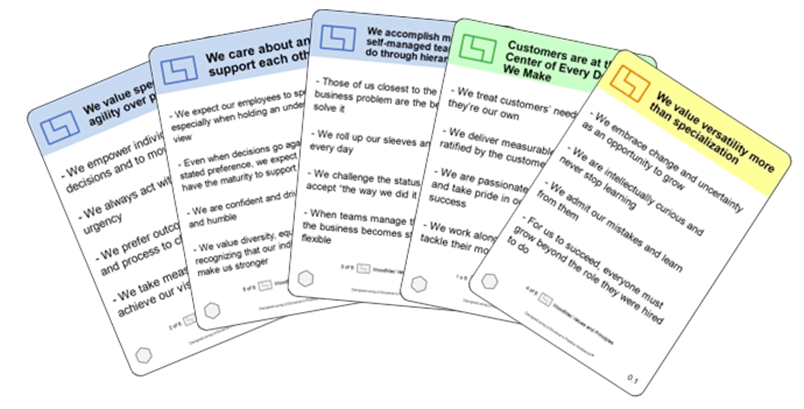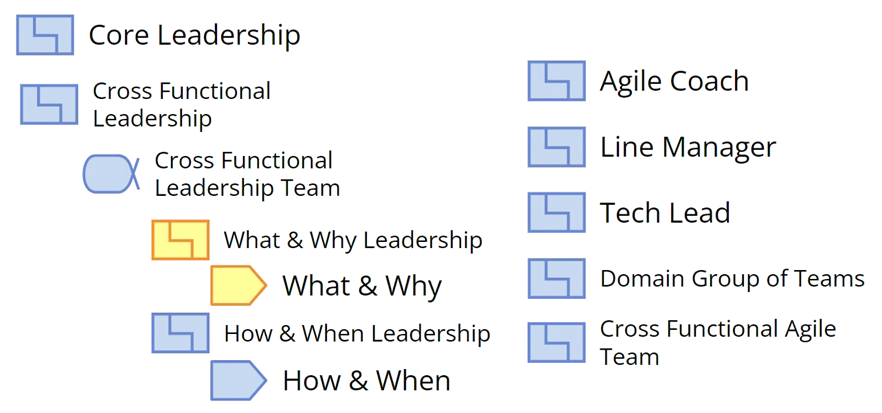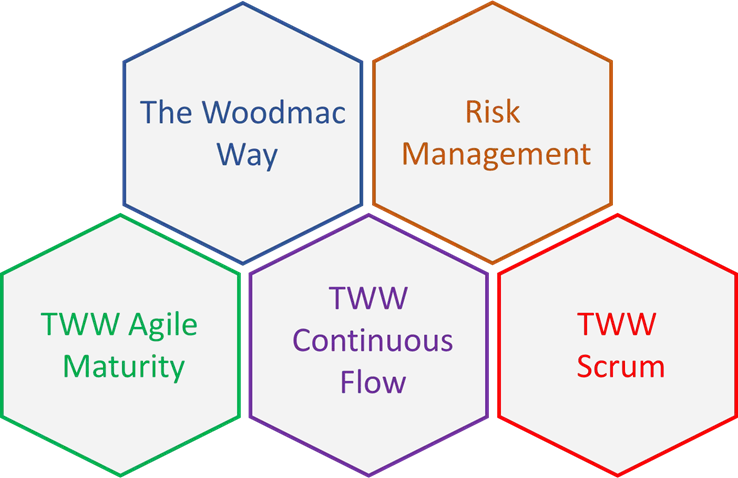In 2021, Wood Mackenzie started a journey to scale and improve their development capability with support from IJI. Whilst the journey started with SAFe, following resistance, it evolved into a practice based approach founded upon the Essence industry standard. The case study below follows that journey from the viewpoint of Wood Mackenzie and shows how sometimes all-encompassing concrete method frameworks struggle to meet the needs of diverse organizations who have many ways of working in-play. This is especially true when teams crave autonomy of approach to properly embrace agile principles.
Whilst working on this endeavor we were reminded that it is typical for big companies to have several methods and frameworks in play (potentially many), with a desire to harmonize and choose just one. This is often very hard to do, because the champions for the different methods don’t have a systematic or objective way to compare and select what should remain in their chosen method going forward. Putting Essence, the industry standard, on the table first, disarms key stakeholders by making them first talk about what they share, the common ground, before talking about what is specific. It makes the method construction or selection challenge much simpler to address.
Defining the Woodmac Way
Introduction
Wood Mackenzie was founded in 1923 as a small, relatively unknown, Edinburgh-based stockbroker. By the 1970s, we had become one of the top three stockbrokers in the UK, renowned for the quality of our equity research. In 1973 our equity analysts published the first oil report and since then we have gone on to create a global research and consultancy business for every interconnected sector of the energy, chemicals, metals and mining, and power and renewables industries we now serve around the world. Naturally, to provide this service to our customers, Wood Mackenzie relies heavily on technology. Over the years we have built up a sizable in-house technology capability of software engineers, data analysts, specialists and other technologists. We have always considered ourselves to be innovative and pro-active when it comes to technology, so our teams are used to using modern approaches in their teams.
Success and Growth
Over the past 10 years, Wood Mackenzie has been through a series of acquisitions, mergers and organic growth that have resulted in a workforce with a rich and varied background, including a wide variety of preferred ways of working. While there are positives with this diversity, it got to a point where the variance in ways of working was beginning to affect our effectiveness.
As a result of a sustained period of rapid growth, ownership change and tactical IT product development, our product development capability had become siloed and inefficient in areas. We needed to get some cross-company consistency back into our approach.
In response, we did what many organizations do. We decided that a common approach to our solution development was required and decided to adopt the Scaled Agile Framework (SAFe®). That was when our relationship with Ivar Jacobson International (IJI) began. As a global leader in SAFe training and consultancy, they were a natural fit to help us on our journey.
Our journey with SAFe
IJI provided high-quality SAFe training to our teams in the UK and USA but the more valuable part was a team of skilled coaches and RTEs that would work with our internal staff to help them get to grips with SAFe. They also supplied an executive coach, as strategic advisor to the global executive, working in support of Bill O’Connell, Senior Vice President of Product Management and a cross-functional network of senior leaders drawn from across the organisation.
Given the diverse background of many of the engineers within the company, the change challenge to mould people to the various SAFe roles and teams into Agile Release Trains was a significant one that was made much easier with the help of IJI’s SAFe experts. said Bill O’Connell, Senior Vice President of Product Management.
On the face of it, SAFe seemed like a sensible and logical choice. Our teams needed to work together on common business objectives and our technical platform is large and complex enough to require multiple teams to develop it. However, it wasn’t going as smoothly as expected.
The way different teams were responding to the new ways of working differed vastly across the organization. Some thought it was a great fit it while others found the terminology conflicted with their existing culture. So although the intent of SAFe was good, some teams had already established agile practices and didn’t feel they needed to change the way they worked. In addition, we were all recovering from the global pandemic and experiencing the complexities of rebalancing virtual and remote working whilst attempting to nurture more agile team dynamics in the new global norm.
If your teams are already practicing agile behaviour, and many are already making good progress, the fact that their particular flavour of agile does not exactly fit with your chosen framework terminology and working patterns can be an issue… why should they change?
Rather than doubling down and pressing on with the planned approach, IJI and Wood Mackenzie started to think more deeply about what the root causes may be and whether there was a better solution.
Organisational Culture Makes an Impact
The process of mergers, organisational changes and hiring of new people had resulted in Wood Mackenzie being a combination of multiple organisational cultures and as new people and teams joined they had largely kept the culture they had before. It was evident that some teams were embracing the scaled agile change because ideas resonated with their background, while other teams found less affinity as they had come from a different environment. Some teams wanted autonomy to do whatever they thought was right, whilst others valued the strong new purpose and strategic direction for Wood Mackenzie. Some teams loved coming up with their own, unique ways of working, while others wanted the reassurance of practices that have been tried and tested elsewhere. Peter Drucker famously said “culture eats strategy for breakfast” – we were watching this happen right before our eyes.
We became increasingly aware that pushing change into certain areas was just going to cause slow-down and push back that we just didn’t need. We needed a new way of thinking that allows for the consistency that we were looking for but at the same time allows for the healthy autonomy that breeds excellence.
A Different Approach is Necessary – Enter Essence
It was becoming increasingly clear that rather than pulling the merged entities of the organisation together, the adoption of a pre-defined framework was proving to be overly divisive and was becoming an impediment to real business change. Taking an evolutionary approach to the ongoing transformation journey, IJI suggested a more engaging experience through the use of Essence – a standard for defining practices and methods. The industry standard of Essence, pioneered by Ivar Jacobson, would allow Wood Mackenzie to balance the needs of all the different constituent teams and of their leaders. Essence could be used to help teams get a deeper understanding of the great practices from SAFe, (and become better at them), whilst also giving teams the flexibility to test and learn good practices from any other agile methodologies as needed.
It was seen that Essence could be used to define a unique way of working that would suit all of Wood Mackenzie and help to build a strong cultural identity across the organisation. Wood Mackenzie teams had indicated a desire to utilise many of the good practices that were already in the Essence ecosystem (such as Scrum, User Stories, Use Cases, etc) so test and learn activities could be quickly initiated with individual teams, thus serving as a real-time accelerator to the overall business transformation.
Essence takes a tailor up approach, starting with the bare minimum and only building on that when necessary. For example, Essence can be applied to leadership and governance practices to create a very light governance layer that empowers teams that work best with high autonomy. It can also be applied to Agile practices by enabling an Agile Coaching Hub to provide test and learn support for teams who want to mature and/or introduce new practices to augment their existing ways of working. Because the Essence based practice approach is always tailored by the organisation for the organisation, the resulting operating model aligns to the internal norms that everyone accepts, avoiding the cultural clashes and tribal responses that people often have towards commercial frameworks.
Rather than adopting a methodology that would be rolled out to Wood Mackenzie teams, Essence enables the conversations for Wood Mackenzie teams to test and learn good practices as they define and mature their own ways of working. Consequently, “The Woodmac Way” would become an accelerator to business transformation in a manner that was completely in line with Wood Mackenzie’s history of innovation, creativity and staying one step ahead.
Creating The Woodmac Way
Considering Wood Mackenzie’s history, it was decided that starting with underlying values was the first step. Once these values were in place, work ensued to select sets of practices that embody them. Understanding the core values and principles that underpin an organization is important when deciding what practices to use and more importantly when helping teams adopt them.

Figure 1 - The Woodmac Way Values and Principles
Importantly, the ideas for practices that formed The Woodmac Way evolved collaboratively with the teams and relevant leaders. This was key to achieving a consensus around the ways of working.
The initiative was centred around the previously formed Agile Centre of Excellence and the Agile Working Group, to help provide direction and support for the initiative.
Getting open collaboration going around the desired ways of working to form The Woodmac Way was a key step in resolving many of the conflicts that surfaced following the previous attempt to move to a one-size-fits-all approach. said Simon Platt Head of the Agile Center of Excellence. Selecting a ‘silver-bullet’ method and attempting to apply it across such a diverse organization as Wood Mackenzie, was a tough ask. Collaboration and the flexibility of the Essence and practice based approach was the key.
Working with Culture and Language
Throughout the transformation, teams continued to work well and evolve / deliver their products. Many team-level practices were working well, so we decided to start with the leadership and governance layer. Many of the SAFe concepts were applicable, but the team were able to consider other ideas from approaches such as Scrum@Scale and the Spotify Model. That is one of the key strengths of the Essence approach, it provides a basis to work from and is clear on what you need to achieve – but importantly, it doesn’t have an opinion on how you get there (which practices to adopt). That’s up to you! That meant we could consider a much wider range of practices and approaches. It helped that the IJI coaches had loads of experience, but they also encouraged us to look at what our teams were already doing successfully, and the language they were using to describe things.
We had experienced legitimate ‘push-back’ from teams on some of the language we had been trying to encourage the teams to start using. Like many established methods, SAFe is quite clear that teams should use the language defined in the method. With Essence however, that is not important. We could use language that made sense for our teams, while still being clear on the purpose of each element. This made a significant difference. Anchoring new ways of working to concepts that teams were already familiar with was important to help them engage with The Woodmac Way.
Many transformational changes fail because teams simply carry on the same behaviours but use new language to describe old activities – they don’t really change at all. This was different. Because Essence has semantics and a language structure, the purpose of each element of The Woodmac Way is clear and so are the relationships with other elements. This makes it easier for teams to adapt to new behaviours even when the words used are familiar.
Separating ‘What and Why’ from ‘How and When’
One of the things most important to Wood Mackenzie was that all the teams should work in line with the company strategic direction. Getting the leadership and governance practices right therefore was critical. Although predominantly an Engineering initiative, there were other stakeholders whose involvement was important, such as Data and Product.
Essences describes practices using a small number of language elements called Alphas, Work Products, Activities and Patterns. By understanding what was strategically important, we were able to come up with a leadership structure based around two core activities: ‘What & Why ‘ and ‘How & When’ and a core ‘Cross Functional Leadership Team’ as illustrated in Figure 2.

Figure 2 - Some of the leadership elements in The Woodmac Way
The two activities help teams focus on what needs to be done and why. This is just enough information for the teams to figure out for themselves how to do something, but, if they need help or an escalation path, one is set out. Meanwhile, the ‘How & When’ meeting helps make sure everyone is aligned with their objectives and helps ensure cross team dependencies are managed.
The other elements are patterns that define the membership of the meetings, roles and responsibilities. Although some elements are inspired by other practices, these are unique to Wood Mackenzie and reflect our culture, values and experience.
Moving towards Coach Led Team Adoption
Whilst the leadership and governance aspects were being thought through, support for teams in the form of coaching was being prepared.
We knew from experience that at Wood Mackenzie the ‘one size fits all’ method approach would not work, so we looked to implement a solution that would avoid it. It centred around using the existing Agile Centre of Excellence as a source of leadership and ownership of The Woodmac Way practices and as a Coaching Hub to deliver support directly to teams.
Providing direct human coaching support is the best way we currently know to help bring working practices to life for teams and engineers. A Coaching Hub to plan and roll-out this support was critical for the success of the transformation endeavour.” said Simon Platt Head of the Agile Center of Excellence. “To me it is imperative that The Woodmac Way ‘Essence’ based practices are owned and supported by our own set of internal Woodmac coaches.
One of the benefits of Essence is that despite requiring a different way of thinking to maximise value, it can be taught relatively easily. Essentialized practices are formed of a number of simple, easily digestible elements (for example, Scrum Essentials is made up of around 30), making it easy to create serious games and exercises to help teams understand, adopt and optimize a practice or parts of a practice. These serious games are straightforward to learn and form a coaching toolkit that coaches can apply to many different practices and combinations of practices.
This means that the coaches are quickly able to learn the basics of Essence and together with a set of powerful coaching tools, help them to coach their teams. The coaching hub applies a simple tried and tested coaching model – Visualise, Stabilise, Accelerate – using a dedicated coaching plan for the different types of team, including leadership and product teams. Each team begins with The Woodmac Way, with other practices introduced depending on the needs of the individual teams. This allows the variance in approach that we saw as so important for our teams. These have also been important inputs into the creation of a number of playbooks as we extend our agile and coaching toolset out across our organisation.
The poker-sized card visualization of practice elements, makes them ideal physical tokens with which to train and coach teams. They lend themselves very well to serious gameplay which helps the team members understand the practices in a fun and effective way.
Some practices have been adopted without change, some (such as Scrum) have been customised slightly to suit our teams’ preferences. There are some unique practices that we have created ourselves.

Figure 3 - Some Practices from The Woodmac Way
By using Essence and the experts from IJI, we were able to create what feels to us like a completely bespoke and tailored method, very quickly – in just a few months. The IJI practice development tooling, in particular, Essence in Practice WorkBench®, played a significant part, in designing, assembling and disseminating The Woodmac Way within the company.
Building out the Coaching Hub
IJI’s approach is always to empower the client to take on the leadership and implementation of the ongoing transformation.
‘You can’t do a transformation to a client’ said Mike Flynn, Principal Consultant with IJI. When organizations take on a change, there has to be a reason for it and the organization has to own it and desire it, or behaviours will simply revert over time. It has to be self-sustaining as soon as possible without external help so that it can evolve with the organization. As we say in the UK, ‘a dog is for life, not just for Christmas’.
The way that this is being done is through the creation of a Coaching Hub owned and led by the Agile Working Group. This coaching hub is the home of The Woodmac Way. It includes the definitions of all the practices, but also a wealth of supporting assets and information such as workshop templates, playbooks, coaching tools, games, facilitation notes, role descriptions and more.
Essence provides a unique and innovative user interface in the form of serious games, cards and highly collaborative team events. Each practice is primarily described in a series of cards (such as the values and principles cards shown earlier) and the cards are used in a series of serious games both when learning the practice, and also when using it. They focus on stimulating powerful conversations within the team, reinforcing their understanding of the practice and helping them ensure they are applying it well and getting the best value from it.
The Future
Working together, Wood Mackenzie and IJI have utilised Essence to create a bespoke way of working that is helping bring together a large set of teams, previously working in very diverse ways, under a common strategic leadership. The teams choose ways of working that suit them and that allow them different levels of autonomy. We are building up a coaching hub, led by our Wood Mackenzie coaches, which was and supported by IJI, that will become a rich source of coaching tools, best practice, serious games, workshop approaches and, more importantly, the centre of a thriving coaching community.
We know that our world will continue to change and that the practices that make up The Woodmac Way today are not likely to be the same ones we will need in the future, especially as we continue to scale the business, but we are confident from the experiences we have had so far with Essence, and the start we have made with the support of IJI, that we will continue to nurture and evolve The Woodmac Way.
For the first time in a very long time, we feel proud and in control of our ways of working said Bill O’Connell , Senior Vice President of Product Management. With the help of Essence and IJI, we are back in the driving seat and feel confident that we have a future-proof way of evolving our working practices over time. Like many organizations we have in the past been guilty of hopping between the most fashionable methods over time, with huge resultant waste. With the Practice based approach, we have a framework that is more modular and will allow us to make more sensible incremental improvements over time.

